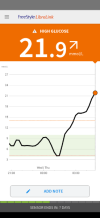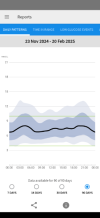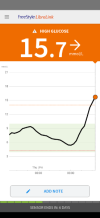Hi all,
I've been diagnosed since 2009 and for as long as I. Can remember I have always dropped blood sugar during the night before it completely spikes. I am on a high dosage of insulin my carb to unit ratio is about 1.5 units per gram of carbs. I am currently on novarapid for food each day and 60 units of tresiba at night. Here is an example of what happened this morning as you can see it's pretty controlled in the day and then when I sleep it starts to drop usually goes to 3.8 before spiking in the early hours in the morning.
I have no control over this as I am asleep. A pump is not an option due to the large quantities of insulin I have to take it would mean a pump change each day essentially I think I am on the right dosage of tresiba anymore and I will drop more than my usual 3.8/4 and it could be dangerous. This morning is quite extreme result where I caught it with over 20 usually I wake up before it gets that high to take a corrective dose of 14 units which see me throughout the rest of my sleep until I am able to get into my morning routine and then I am able to control again.
First picture is an extreme example from this morning which made me feel awful due to how high it went and then the second is my 90 day average to show I am fairly good at controlling when I can. It's just frustrating that I can't control while I am asleep.
I've been diagnosed since 2009 and for as long as I. Can remember I have always dropped blood sugar during the night before it completely spikes. I am on a high dosage of insulin my carb to unit ratio is about 1.5 units per gram of carbs. I am currently on novarapid for food each day and 60 units of tresiba at night. Here is an example of what happened this morning as you can see it's pretty controlled in the day and then when I sleep it starts to drop usually goes to 3.8 before spiking in the early hours in the morning.
I have no control over this as I am asleep. A pump is not an option due to the large quantities of insulin I have to take it would mean a pump change each day essentially I think I am on the right dosage of tresiba anymore and I will drop more than my usual 3.8/4 and it could be dangerous. This morning is quite extreme result where I caught it with over 20 usually I wake up before it gets that high to take a corrective dose of 14 units which see me throughout the rest of my sleep until I am able to get into my morning routine and then I am able to control again.
First picture is an extreme example from this morning which made me feel awful due to how high it went and then the second is my 90 day average to show I am fairly good at controlling when I can. It's just frustrating that I can't control while I am asleep.



